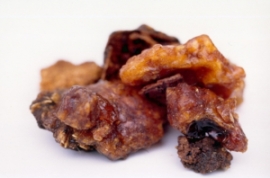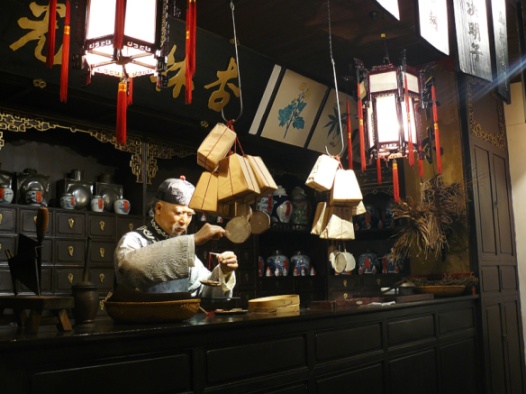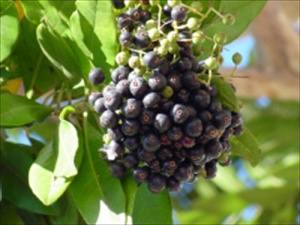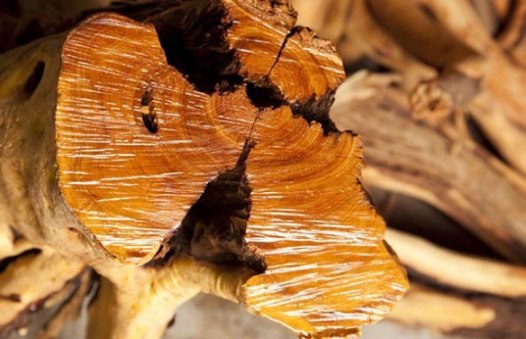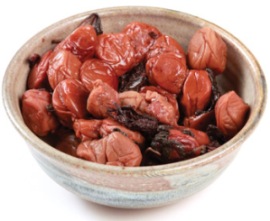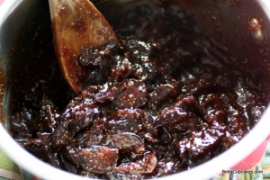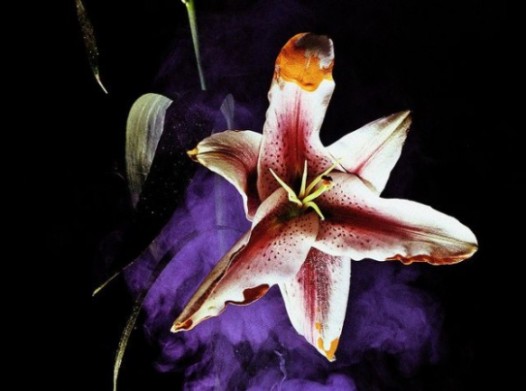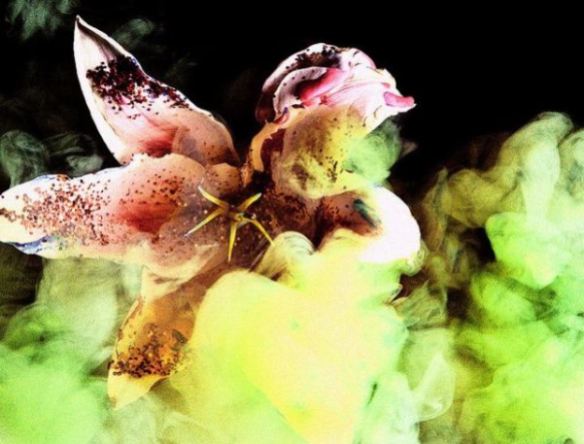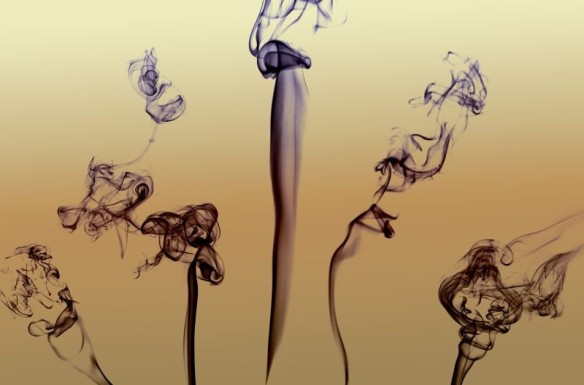Close your eyes, and imagine a pool near the Mekong River in France’s old South-East Asian colony of Indochine. The thick, sultry air swirls around you as you dive in. It’s a pool of decadent, creamy custard that is a bright egg-yellow, unctuous, thick, endlessly creamy, and sweet. As your head hits its top layer, your body is coated by dark vanilla and golden honey, but quickly you are surrounded by flecks of green. Nutty, green cardamon with its warm, toasty edge mixes with the custard. Subtle specks of dry smoky incense touch your lips, but everywhere around you is cream, cream, cream. So golden, so heady, so rich, so luxurious, you fall in deeper and deeper. A sweet milkiness swirls with the toastiness, the custard, and the nutty cardamon to create café au lait. Like a 1960s psychedelic trip, the colours have changed from golden, egg-yellow, to green, to creamy, mocha brown. You’re cocooned in warmth and sweetness, but dryness and smoke linger in the air and soon take over, until all that is left is a patina of dry, creamy, sepia-tinged vanilla that kisses your skin like the warm air of Indochine.
That is the tale of my journey with Indochine (or PG25 Indochine), the 25th creation of the French niche perfume house, Parfumerie Générale. It is an eau de toilette that is named after the former French colony in an area of South-East Asia that was once referred to as Indochina, and whose territory encompasses what is now modern Cambodia, Laos, and Vietnam. Parfumerie Generale’s founder, Pierre Guillaume, is often known for creating gourmand fragrances, but Indochine doesn’t truly fall into that category. For all the perfume’s sweet touches, there are plenty of dry, smoky, woody notes to act as a counter-balance, creating a beautiful, addictive, compulsively sniffable fragrance that is extremely wearable, unisex, and cozy.
Parfumerie Generale’s website explains the inspiration for Indochine, its feel, and the characteristics of some of its notes:
1920 : a sepia-toned cruise following the course of the mighty Mekong River, a kaleidoscope of ephemeral dawns shrouded in mist and glorious days of radiant sunshine.
Slow down, just enjoy the dampness and close your eyes. Beyond the riverbanks, our dreams of Indochina…
At once sweet, vanilla-scented, resinous, powdery, milky and spicy, Benzoin Siam is a resin of great olfactory richness that is rarely used as a central theme in Perfumery.
Drawing on rare notes such as Kampot Pepper, Burmese Tanakha, or Laos honey, Pierre Guillaume orchestrates a luminous, smooth and airy perfume, delicately reproducing each and every facet of the unprocessed balsam. [¶] This sepia-tinged balm infuses Indochine with the radiance of platinum…
The short summation of the perfume’s notes is as follows:
Benzoin Siam Resin, Kampot Pepper, Ceylon Cardamom, Burmese Tanakha, Laos Honey.
I think it’s impossible to understand Indochine without discussing a key ingredient that I’d never previously heard of, let alone smelled: Tanakha (or Thanaka, as it is sometimes written). I did some digging, and found a very useful explanation in CaFleurebon‘s review of Indochine:
In reading about Tanakha it is a native tree to Burma which is ground into a fragrant paste used in makeup. As a note in perfumery it shares a lot of similarity to sandalwood. It has the slight sweetness of sandalwood but it also has a hint of green quality which replaces the creamy quality of sandalwood.
Elsewhere, I’ve read that Thanaka paste has “a slight flowery aroma to it something akin to a fragrant light sandlewood.” It is highly popular as a cosmetic paste in South-East Asia, and a simple Google Images search brings up some wonderful photos of women or girls with beautiful, decorative, artistic swirls of Thanaka on their faces.
Indochine blows my socks off with its stunning opening. It’s an utterly intoxicating swirl of sweetness and creaminess: rich, toasty, nutty notes mixed with vanilla and honey. Fast on their heels is a green, spicy, nutty cardamon, then a milkiness that smells a lot like the sweetened milk left in your breakfast bowl after you’ve had frosted cereal. Subtle tendrils of smoke, as light as a summer’s breeze, float at the top. Flecks of pepper with a surprisingly aromatic fragrancy dance at the edges. The combination positively makes my head spin in appreciation; I can’t stop sniffing Indochine not only because of how intoxicating it is, but also because of a quiet mysteriousness that is hard to describe.
It tugs at me, intrigues me, and leaves me scratching my head a little. I think it’s that Thanaka — which is definitely one of the more fascinating wood elements I’ve encountered — in conjunction with the other notes. To be honest, having never smelled it before, I’m not sure where the aroma of Thananka begins, where it ends, or what other factors may be responsible for what I’m smelling. Whatever the specifics, the overall result is a stunning, sweet, spicy, smoky woody creaminess. Indochine smells so warmly rich and unctuous, it’s like a custard. Yet, it is one which is infused with subtle smokiness, a green spiciness, a toasted rice and nut accord, and milky sweetness. The whole thing sits atop a rich base of Siam benzoin with its vanillic characteristics. After a few minutes, the slivers of honey melt, no longer discernible as pure honey, and become an additional layer of sweetness in that custardy richness.
Despite all that, Indochine is not wholly gourmand in nature. I don’t like cloying dessert fragrances, and I think Indochine has an increasing dryness which helps ensure it never falls headlong into the gourmand family. The fragrance really straddles the line between that and the woody category. In large part, it’s thanks to the Thanaka wood paste which has not only a lovely dryness but, also, a slightly smoked aroma. The cardamom helps as well, even though its primary characteristic here is of toasted nuttiness subtly infused with green spiciness.
Ten minutes into Indochine’s development, my primary impression is: creamy, creamy, creamy. The whole thing feels like a dessert at times, only a dry one that is surprisingly lightweight in feel. In fact, it’s almost airy, despite the fragrance’s initial headiness. Indochine is a decadent, utterly addictive, warm, sweet, rich, mellow cloud of creamy woods. A vaguely floral note dances around the edges, but what is increasingly noticeable is a milky aroma. I have no idea where it comes from, but I suspect it is yet another characteristic of the thanaka. The wood is apparently too light to be like true, creamy, Mysore sandalwood, but perhaps the more diluted aroma takes “creaminess” and translates it to “milkiness.” The Thanaka is really, really beautiful. Whether it originally smells like Mysore sandalwood, I don’t know, but the supplemental notes in Indochine have added the necessary spicy, creamy, smoky sweetness to make its aroma quite similar.
The cardamom is equally lovely. It feels simultaneously green and brown, fragrant and dry, toasted and nutty. In fact, that toasted note is an interesting characteristic, in and of itself. At first, it reminded me of toasted rice, but as the moments progress, and as Indochine grows richer, milkier, and more custardy, the note smells more like toasted rice in a milky, cardamom pudding. The whole thing is nestled in a sweet cocoon of silky smooth, soft, billowy Siam benzoin, and lightly flecked with the most subtle tendrils of dry, black smoke. The over-all effect is more than just delicious; it’s compulsively sniffable and wholly addictive.
Indochine continues like that until the end of the first hour when it becomes much drier and smokier. Some of the perfume’s richness and sweetness have receded as a result, though Indochine is still very creamy when sniffed up close. Still, the perfume feels thinner and less lushly unctuous than it did in the first 30 minutes. As a whole, the fragrance is a beautiful blend of creamy sandalwood-like woods infused with a light smokiness. A subtle cardamom nuttiness is sprinkled on top, while underneath is a delicate, thin base of milky, sweet vanilla.
As the fragrance gets drier, the visuals start to change. Two hours in, Indochine slowly begins to morph away from the custard, and into toasty, sweetened coffee. Indochine increasingly smells like a very creamy, but dry, Café au Lait sprinkled with toasted hazelnuts and vanilla. It’s an incredibly comforting, cozy, soothing scent, though it lies just a few inches above the skin. With every passing hour, Indochine fades in sweetness, strength, and projection, turning drier, woodier, and increasingly blurry in texture. By the middle of the third hour, Indochine is just a skin scent, radiating a dry, vanillic, woody sweetness that is still slightly creamy and smoky in nuance. The notes have lost any distinctive, individual form, but the abstract version of Indochine is still enormously appealing.
Indochine remains that way for the rest of its duration. In its final moments, the fragrance is nothing more than a faded trace of dry vanilla with a hint of something intangibly woody underlying it. The longevity was extremely surprising to me; I frequently thought Indochine had died on my skin, only to find it clinging on tenaciously. I was sure it had died away after the seventh hour, the eighth and the ninth, but, all in all, Indochine lasted 10.75 hours on my perfume consuming skin. The sillage was extremely low after 90-minutes, and Indochine became a skin scent shortly after the 2.25 hour mark, but apparently, it’s supposed to be that way. For one thing, it is an eau de toilette, and thus, a much weaker concentration of fragrance. For another, Pierre Guillaume seems to have intended for Indochine to be a “sepia-tinged balm,” as he puts it. CaFleureBon summed it up best:
Indochine has excellent longevity and slightly below average sillage. Indochine tends to add a perfumed coating like sepia does to photographs, subtle but striking. [Emphasis in the original.]
I loved Indochine, and would be utterly determined to get a bottle if it weren’t for one thing: ISO E Super. As my experience with Parfumerie Generale’s Dhjenné demonstrated, Pierre Guillaume seems to love the blasted aroma-chemical, and he used it there with frenzied abandon. It’s different in Indochine; there is nothing remotely antiseptic, medicinal or even hugely peppered in feel to the ISO E Super here. However, exactly 35 minutes in Indochine’s start, there was a noticeable woody hum to the base of the perfume. It got louder and louder, until, at the 45 minute mark, its forceful thrum was matched by a sharp throbbing at the back of my head. Soon, it turned into pounding. Then, a new characteristic arose: my eyes started to feel watery.
I am not one of those people who consistently and perpetually gets migraines from ISO E Super, but I do when a hell of a lot of it is used. To avoid a complicated, gobbledygook explanation, the basic gist is that ISO E Super has extra-large molecules that seem harder for the nose to absorb. What was interesting with Indochine is that my headache initially faded after 15 minutes, but only because I didn’t bring my arm to my nose to smell all the layers in the fragrance. However, the minute I did, it was as if a searing hot poker had been rammed straight up my eyeball to the back of my head. I tested Indochine twice, and it was an utterly brutal experience each time during the first two to three hours. The moment I brought my nose to my arm, my headache returned. Instantly. I obviously had to smell the damn perfume to detect all its underlying layers, so I persisted, but it was a painful experience. And, again, I have to emphasize, I have this reaction only when a lot of ISO E Super is used. On the plus side, at least this version of ISO E Super didn’t smell like hospital antiseptic on my skin, because it certainly has happened in the past.
Indochine is so utterly addictive that I honestly tried it the second time solely to see if I could move past that headache stage. After all, no-one said I have to actually sniff it up close if I’m just wearing it for pleasure, did they? It’s an easy, versatile, incredibly cozy, comfort scent that also happens to come in a range of sizes that are quite affordable. It’s a testament to how much I — a person who rarely likes even quasi-gourmand scents, and who loathes ISO E Super with a violent passion– loved Indochine’s opening that I was willing to contemplate almost guaranteed headaches to wear it. Unfortunately, at the end of the day, I simply can’t do it.
Most people, however, can’t detect ISO E Super if it were used to cudgel their brains out. (Lucky devils, you have no idea how much I envy you.) So, unless you’re one of those who knows they are sensitive to it (or to one of the many, many ISO E Super fragrances listed in my article), you have no need to worry. If you love sweetened sandalwood fragrances, if you’re looking for a very dry gourmand fragrance that isn’t extremely foody, or if you enjoy comfort scents, then I strongly recommend that you try Indochine.
The lovely Suzanne of Eiderdown Press has a gorgeous, evocative, and very eloquent review of Indochine. If I could, and if it weren’t so heinously rude, I would copy it out almost in full because it really is beautifully written and moving. I’ll include the relevant parts here, but I strongly encourage you to read the whole thing on her site:
Parfumerie Générale Indochine—a contemplative fragrance that, for all its quietude, somehow manages to be arresting on an emotional level. The strong pull of nostalgia is what lends the light-wearing Indochine weight. Initially it smells like a sandalwood box in which photographs, letters and other precious mementos have been tucked away: poems copied in a lover’s hand, shells from a distant shore, partially burned incense sticks and dusty candles. As the scent develops, though, it goes through a subtle shift, and in its dry-down stage there is a sanded-smooth sweetness to Indochine that is so easy-wearing and comfortable, it makes one feel good about being in one’s own skin.
In the first half-hour of wear, there is a parched and incense-like quality to Indochine. It most resembles a smoky sandalwood scent at this early stage, and if I were to describe its character, I would call it exotic yet reserved. The tingly spiciness of cardamom and pepper intersecting with the light acridness of honey mimics the smell of tobacco, and the combination not only lends an air of aridity to the scent, but is one of the reasons I picture the fragrance in my mind as a sandalwood box, as every good box must have some hand-rolled cigarettes stashed inside. Indochine’s benzoin is more resinous than vanillic at this point, again contributing to that wooden trinket-box smell. […]
Eventually the benzoin does begin to smell more vanillic, and the smoky, incense-like character of Indochine fades considerably after about an hour into its wear. Though the fragrance loses its exoticism in the process, the your-skin-only-better scent that is left behind is not a bad souvenir—no, not bad at all. There is still enough woodiness in the drydown to keep Indochine interesting and to prevent it from edging over into the kind of sentimental sweetness that would take away Indochine’s backbone.
Suzanne says Indochine “makes one feel good about being in one’s own skin,” and I very much agree. My experience obviously differed somewhat from hers in the details, but then my skin tends to amplify basenotes along with sweetness. Still, we were both cleared swept away by what we smelled, and by the beauty of that sandalwood-like thanaka. So, whether you experience my smoky, milky, toasty rice, cardamom custard followed by nutty, dry café au lait, or Suzanne’s sandalwood box of treasures infused with spices, a subtle tobacco-y nuance, and parched incense, I think you’ll generally be in very good hands with Indochine.
There is one exception, however, and no, it does not pertain to the ISO E Super. It has to do with the honey. People whose skin chemistry turns the ingredient into something sour, urinous, or animalic should test Indochine first. On Fragrantica, the handful of negative reviews all involve problems with honey. To quote one commentator, “Now I know what Tania Sanchez meant when she said ‘the rest of us are howling’ when she referred to Serge Lutens Miel de Bois.”
Outside of that narrow category, however, everyone else seems to adore Indochine. Fragrantica commentators alternatively described the fragrance in dessert terms, or as something darkly smoky, resinous and peppered. (I bet that some of that “pepper” note is due to the ISO E Super, but they don’t realise it.) My favorite review is from a commentator, “meama,” who seems to love food as much as I do:
Indochine is a real melting of spices, like a chocolate fondant: dry and crisp on the outside, soft and flowing in the center. And most importantly, delicious.
Its crust pepper and cardamom crackles under the nose with a little something of toast, black and dry. Then benzoin starts slowly to pour the flood of sweet resin, vanilla, powdered, soft like white sand. Already, a first contrast between dark cold spices and enveloping milky balm. Honey is slowly making its waxy and animal facet participant in turn to a new dimension of flavor, more syrupy, which evokes a black licorice slightly aniseed, such absinthe or ageless whiskey.
On the skin, Indochine takes root, its mineral and syrupy animality clings to the skin without looking tacky, with a discreet diffusion.
Like all the PG creations the longevity and the sillage is disappointing.
On my skin, the honey melted into the base, and was never a distinct part of the fragrance after the first five minutes. Indochine was also never animalic in the slightest. That said, I agree very much with the overall feel and spirit of his experience, as I do with Suzanne’s beautiful, ancient, sandalwood box infused with something akin to parched incense, and followed by sanded-smooth sweetness. Indochine is all those things. It’s not complicated, revolutionary, edgy, or complex, but it is truly lovely and intoxicating.
As a side note, two commentators on Luckyscent said that Indochine resembled some other fragrances. One brought up Indochine’s sibling, and another Parfumerie Generale creation, Cadjmere: “it is sooooo similar to Cadjmere, slight differences, but both are gorgeous.” I’ve never tried Cadjmere, so I can’t compare. A second reviewer found Indochine to be quite close to an Ava Luxe fragrance: “This is nearly identical to Ava Luxe Bois Exotique, but I like Indochine better because it is so smooth and rounded. The Ava Luxe is a tiny bit harsher.” Again, I don’t know the fragrance, but, if you’ve tried or own either one, you may want to keep the alleged similarities in mind. My reference points are different, so what I would add is this: those of you who love Etat Libre d’Orange‘s Fils de Dieu should definitely try Indochine. I think you’d like it because it has the same sort of vibe, even though Indochine is smoky, woody, and drier. By the same token, if you didn’t have much success with the new Dries van Noten from Frederic Malle (a perfume I really dislike, by the way), and if you love gourmands, you should also look into Indochine. The aroma of the thanaka is what I expected from the Malle fragrance, and not the unpleasant, weird, ersatz “sandalwood” that I got instead.
In short, if you enjoy sweet, but dry, woody scents that are easy, uncomplicated, infinitely cozy, and just slightly tip their hat at the gourmand category, then I’d definitely urge you to give Indochine a sniff.














